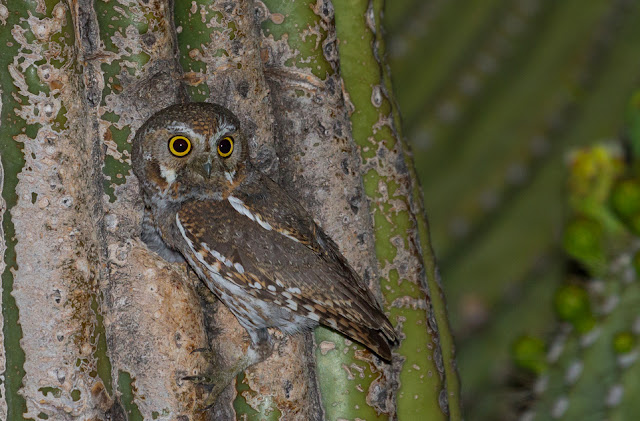Finding the World’s Smallest Owl in the Desert Night
By Jennie MacFarland
 |
| Elf Owl by Jeremy Hayes |
People love owls and it’s easy to see why. They are engaging and dynamic and their nocturnal habits make them a little mysterious. When we see an owl it stands out as such a special and meaningful experience. This is partly because such instances are so rare, but it also has to do with the weighty presence of the birds that is difficult to describe. It’s no wonder owls have been significant to cultures all over the world and through time—it’s always exciting to hear or see them. Their forward facing eyes give them an oddly human expression of wisdom or pensiveness that only adds to their appeal. All of this no doubt contributes to the huge popularity of our annual Elf Owl Survey in the Tucson area.
Tucson Audubon started organizing these Arizona Important Bird Areas (IBAs) surveys in 2018 to gather important data on two of our then-new IBAs: Tucson Mountains IBA west of Tucson and Tucson Sky Islands IBA east of Tucson. Elf Owls are a species that can qualify a site as a Continental level IBA if you document enough pairs or individuals. Surveys are the best way to do this and also happen to be great fun!
 |
| Almost time to start the survey! |
Elf Owls are active only at night so these surveys involve teams walking Saguaro National Park trails at night while keeping an eye out for all night dwelling creatures. The Park was very supportive from the beginning, providing special access for the surveys—in 2021, Pima County did the same for Tucson Mountain Park. Huge thanks to our amazing partners, we could not do these surveys without your guidance and support.
Elf Owls hold the distinction of being the world’s smallest owls, though their attitudes are anything but small. They are voracious predators that hunt prey such as moths, scorpions, centipedes, small lizards, and pretty much anything else they can catch. They spend the winters in Mexico and return to our Sonoran Desert habitat in late March to nest in saguaro cavities. Once they are done raising their young and teaching them how to be excellent hunters themselves, they return to Mexico in early fall. It is such a treat to hear their laughing call after sunset, a true sound of the desert in spring! These adaptable birds are associated with saguaros and desert, but they will also nest at much higher elevations. They can be found nesting in woodpecker holes in oaks and sycamores throughout Sky Island mountain ranges such as the Patagonias and the Huachucas.
 |
| The various creatures of the night |
Surveys this year were held on the two days leading up to the full moon of April. This timing provides increased ambient light for volunteer safety, and there’s also evidence that small owls are more likely to call on moonlit nights. We had a great turnout this year with 67 people participating to cover 34 survey routes. Together we documented 187 Elf Owl territories within the two IBAs. This is excellent!
There were many other bird detections: 87 Western Screech-Owls, 56 Common Poorwills, 41 Great Horned Owls and 31 Lesser Nighthawks, and less expected sightings including Gray Fox, Western Banded Gecko, and lots of insects and tarantulas! Probably the most surprising sighting was by my sister on my team: a Virginia Rail roosting next to a prickly pear out in the desert! Very strange—I am so glad I got a photo or I wouldn’t believe it myself!
 |
| Virginia Rail in the desert?? |
The 2022 Arizona IBA Elf Owl survey was a huge success due to our amazing volunteer surveyors and excellent partners in Saguaro National Park and Pima County. Thank you all!
- The results for the 2022 survey can be seen here on this interactive map.
- If you’d like to learn more about Elf Owls, this short PBS video is well worth your time!
Jennie MacFarland is Tucson Audubon’s Bird Conservation Biologist and jointly runs the Arizona Important Bird Areas Program with Tice Supplee of Audubon Southwest.


Comments
Post a Comment
Thanks, we value your opinions! Your comment will be reviewed before being published.